
Steamboat People, page 5
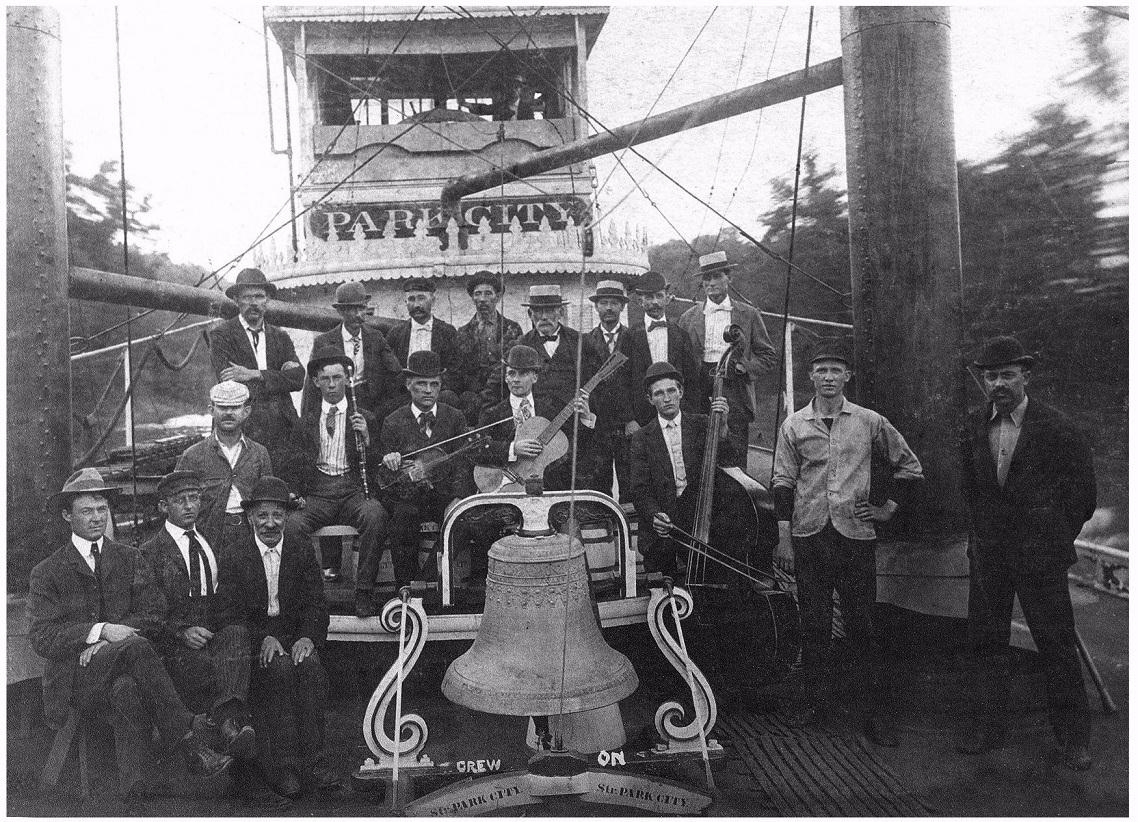
From John Hartford's personal collection
Photograph of the steamboat PARK CITY from John Hartford's personal collection from which Ralph Du Pae of LaCrosse, Wisconsin kindly had an 11 x 14 print made for me Included are 4 musicians, what appear to be 3 members of the crew, 11 passengers and a pilot at the wheel in the pilot house.
Players with their instruments: Clarinet, Fiddle, Guitar & the Bass Fiddle player who appears to resemble actor Paul Newman.
Boat was in motion as evidenced by the "action blur" on foliage behind the boat during the camera's brief time-exposure.
PARK CITY
Sternwheel Packet
Owned by Captain E.W. Bewley
Clerks: Jake Kittinger; J. Edgar Williams (clerk); Jett Hines (clerk)
Ran on the Ohio River; Green River; Kentucky River
Way's Packet Directory Number 4392
Built in 1883 at Brownsville, Pennsylvania as the GAYOSO. Her name was changed to PARK CITY in 1897. In the beginning of her career, she ran Evansville-Green River. Later on, she went to the Kentucky River where, on December 6, 1909 near Glenmary, Kentucky she was lost due to a peculiar accident. She had a large shipment of whiskey in barrels and cases on board. As the boat rolled while approaching the landing, one of the barrels fell from its place high on the main deck, crashed through the deck and into the hold, went through the bottom planking and sank the PARK CITY. The total loss was $7000 to the steamer and $1000 for the cargo.
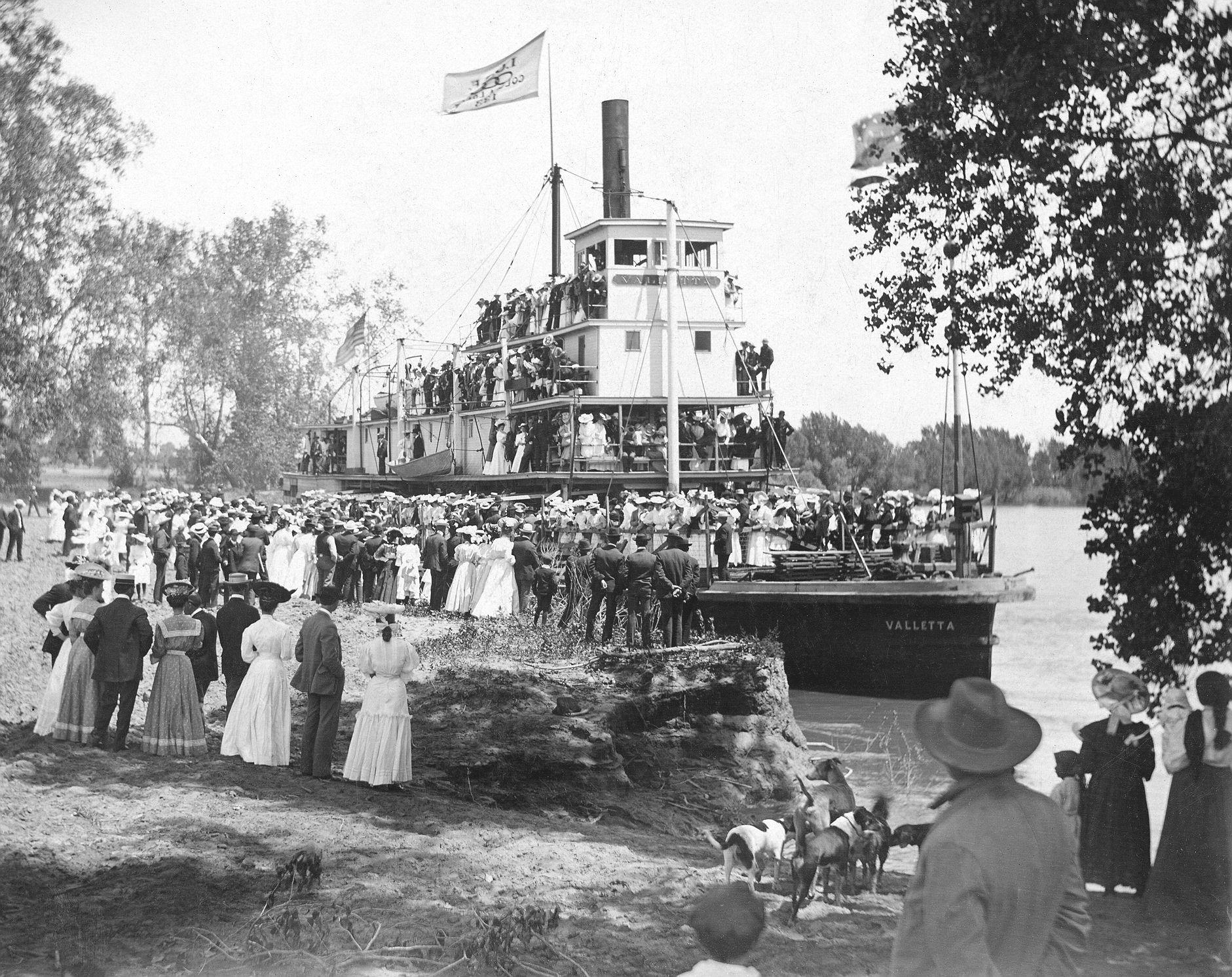
Steamer Valletta. Just bought this photo today at a Pasadena postcard show. The Valletta (built in 1901 destroyed by fire 1932) was a Sacramento River boat. They're providing transportation for an Odd Fellows picnic here. (I confirmed it was an outing for Lodge 133 at Colusa on the Sacramento River.)
This almost looks like a movie still with a bunch of extras. My favorite part (outside of the boat) are the dogs in the lower right corner. Feels like you could step right into this picture doesn't it? There isn't a date on it but I'd guess very early 1900's, not long after it was built. Thought I may have scanned this crooked but the people are standing straight so the boat must be listing towards the shore with too many passengers on that side.
The original photo measures 6-1/4 X 8 inches, mounted on a larger piece of board.
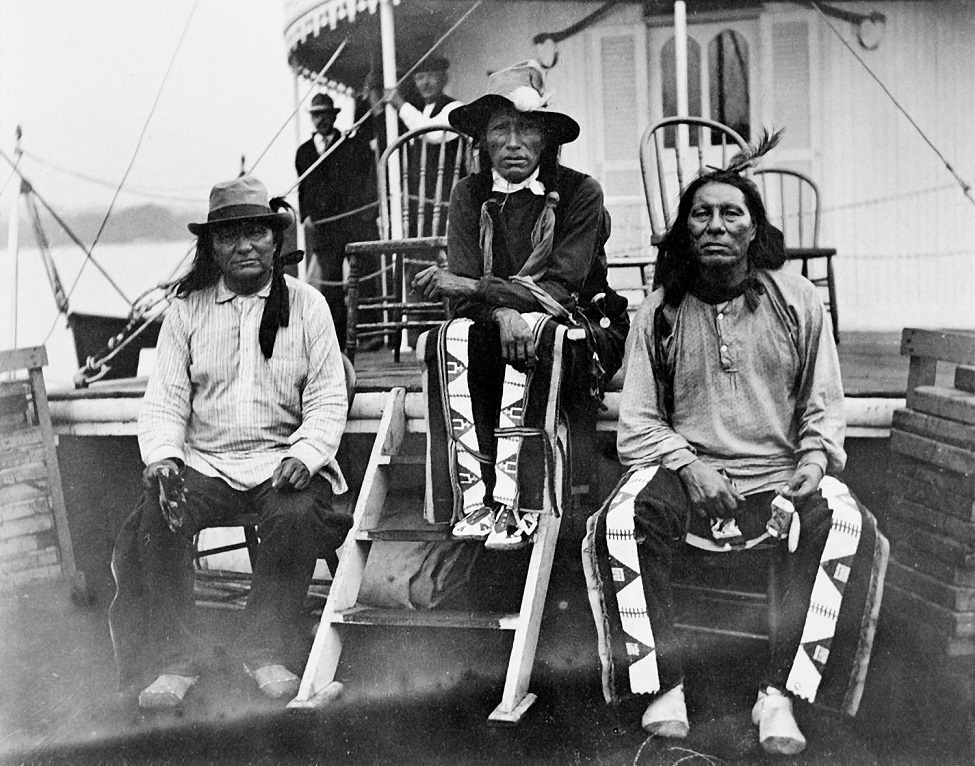
Native Americans aboard the QUINCY
Unusual photograph of three Native American men seated in front of the texas cabin. They could have been traveling with the Wild West Show that was traveling between river towns aboard the QUINCY. From La Crosse Museum collection.
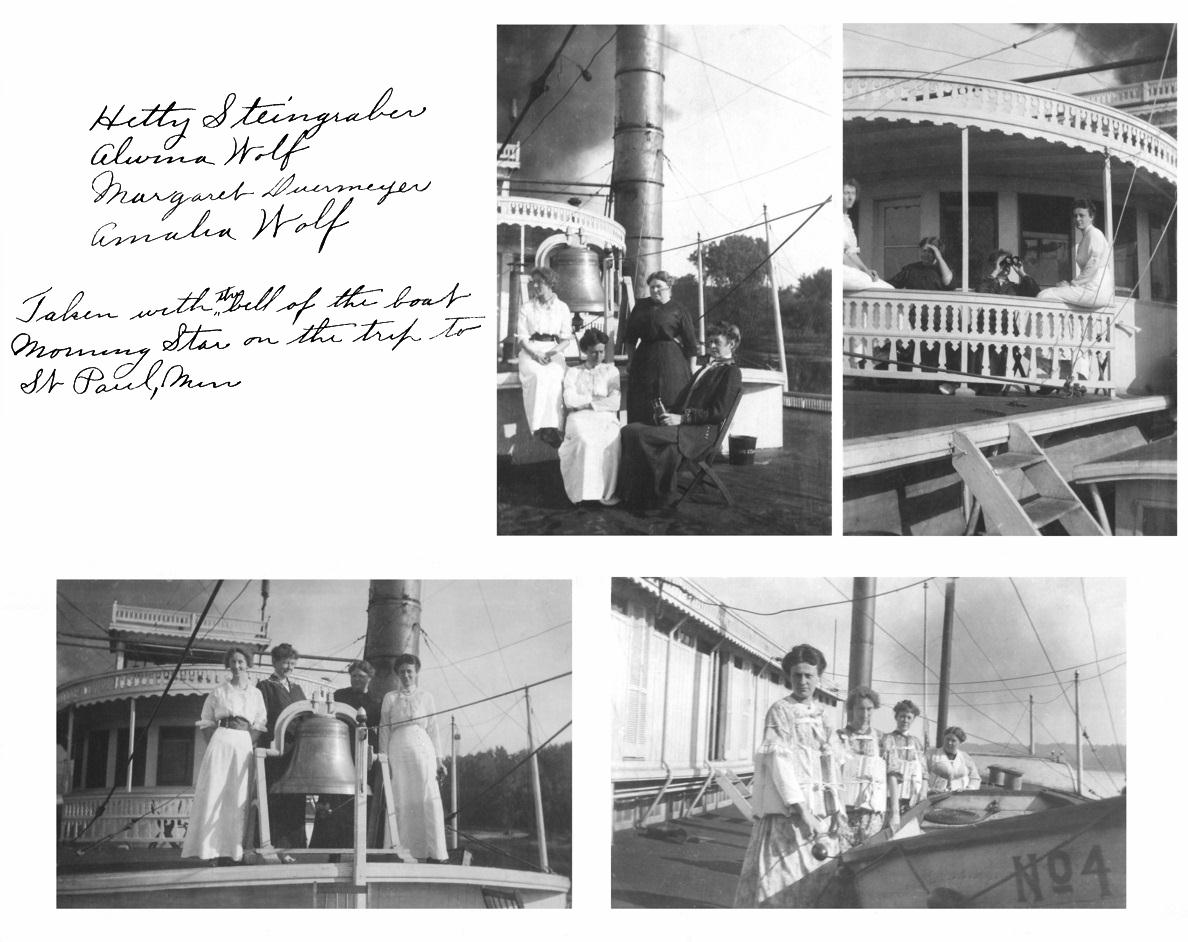
MORNING STAR 4 ladies on board
Attached 4 snap shots of ladies taken aboard the MORNING STAR. The ladies were identified on the back of the first vertical photo upper left at center: Hetty Steingraber, Alwina Wolf, Margaret Duermeyer and Amalia Wolf.
Photos feature the texas cabin, including the "front porch" and above in background, the pilot house, port side stack, smoke and life boat No. 4 which the ladies were ordered to board wearing life vests during "an awful storm on Lake Pepin" while the boat was on its way to St. Paul, Minnesota.
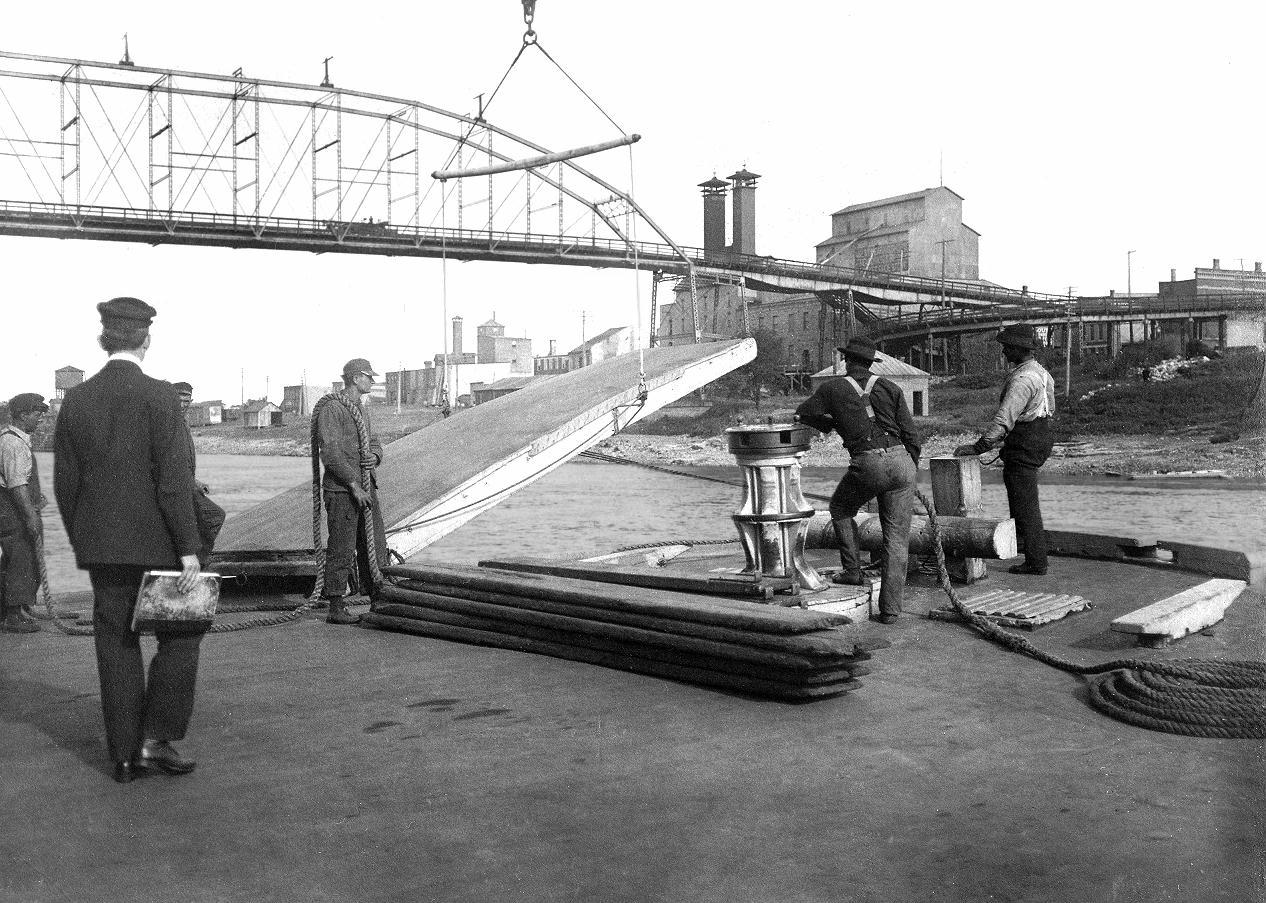
MORNING STAR
Sidewheel Packet/Excursion boat
Way's Packet Directory Number 4043
Built in 1901 at Jeffersonville, Indiana by Howard Ship Yard
Originally ran in the Louisville-Evansville trade.
She was taken to Cincinnati in 1910 and had 25 feet added to her length forward of the boilers.
She then ran in the St. Paul-Davenport-Stillwater trade under the command of Captain Walter Blair.
In the summer of 1911 she ran a special cruise from Davenport to New Orleans and out to the Jetties and return.
A similar excursion planned for April 1912 was canceled due to high water; instead she ran an excursion from Davenport-Cincinnati and back.
In May 1914 she made a special trip from Davenport to the Tennessee River.
By June 1914 she was back running in her usual trade.
In the fall of 1915 she made a tourist trip from St. Louis to New Orleans.
In May 1916 she made a Davenport to Florence, Alabama trip.
She was sold in spring 1918 to the Coney Island Company of Cincinnati to replace the PRINCESS.
She was made into a full-scale excursion boat continuing in the Cincinnati-Coney Island trade until she burned at Cincinnati on November 4th, 1922.
The fire was caused by a watchman boiling tar on the galley stove for roof repairs.
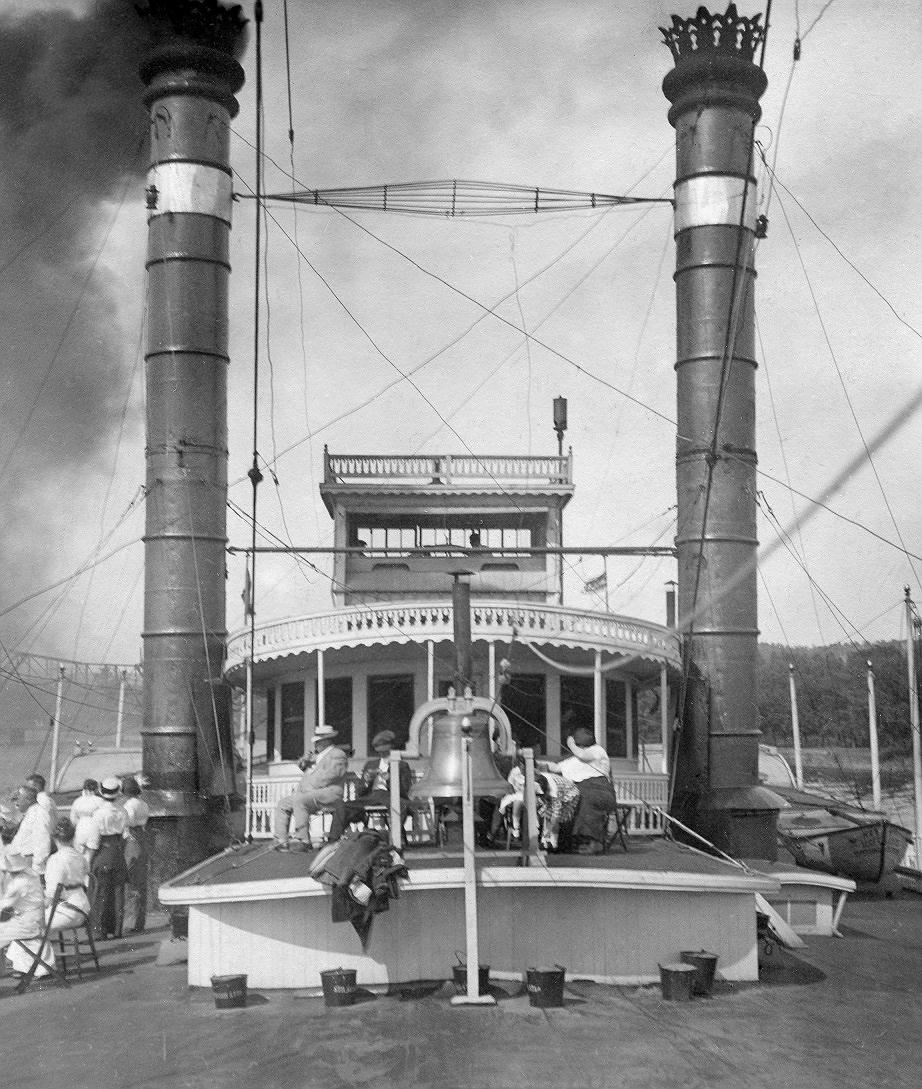
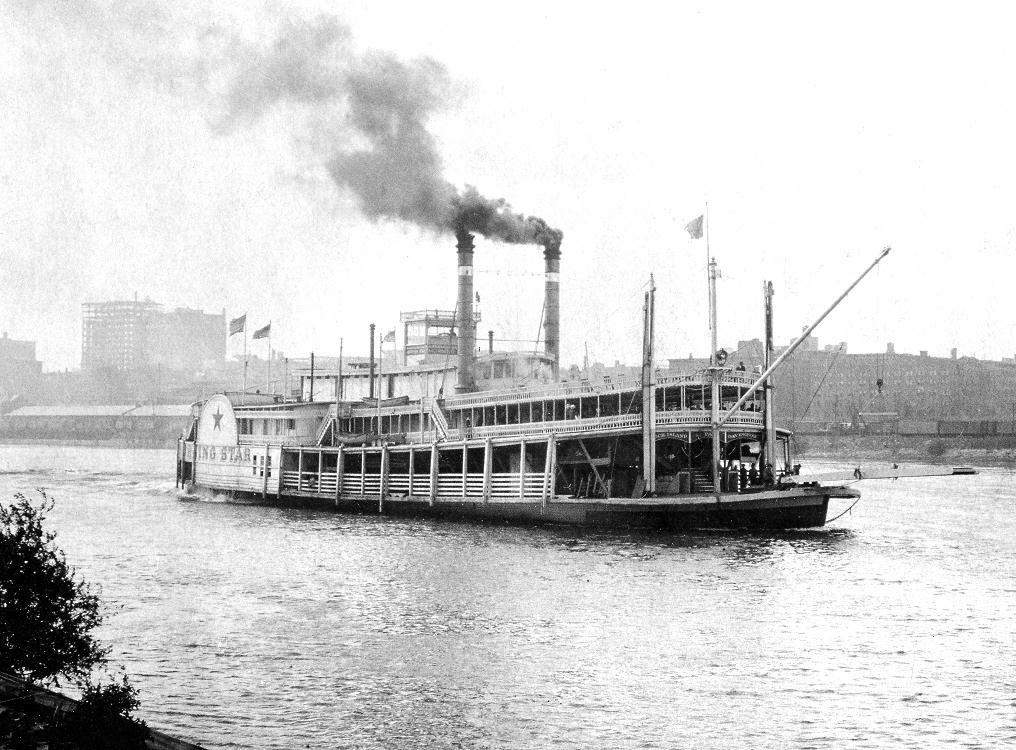
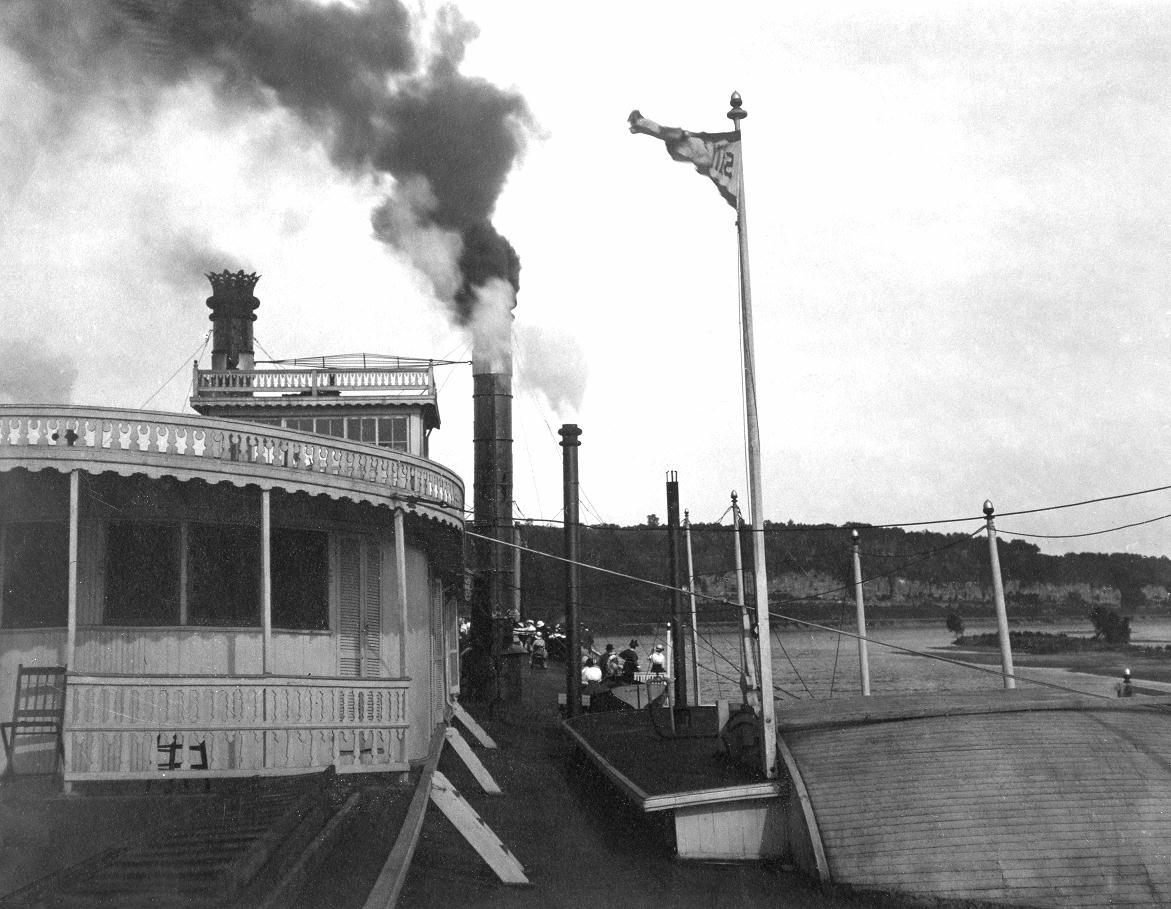
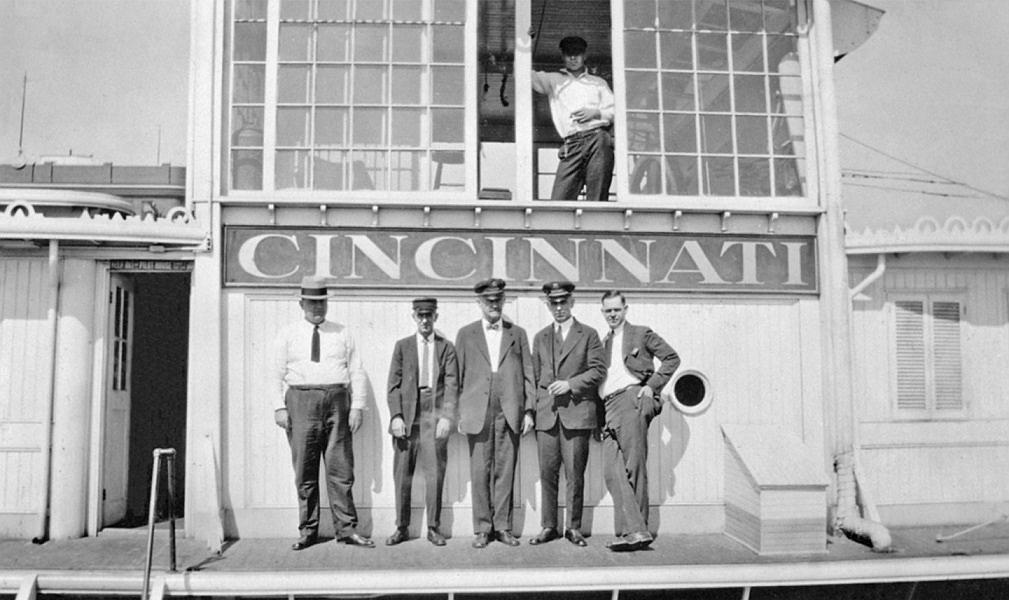
Cincinnati (Packet, 1924-1932)
Plumbed, cropped & enhanced from a La Crosse photo, an interesting starboard detail of the CINCINNATI. The fellows standing below the pilot house window were identified from left to right were:
Burnside; Atkinson; Lindenburn; Wrigleworth and Kirby.
The unidentified fellow in the pilot house anticipated the male models who would promote Marlboro cigarettes beginning in 1954 (except they would wear Stetson cowboy hats).
CINCINNATI
Sidewheel Packet
Way's Packet Directory Number 1033
Hull built by Midland Barge Company, Midland, Pennsylvania, the rest completed at Cincinnati, 1924 This boat had a double cabin, parlor rooms, baths, separate dining room, steam heat and all the trimmings. She was designed by marine architect Tom Dunbar as a single-cabin packet for the Cincinnati-Louisville trade. Before completion, the stateroom capacity was vastly enlarged by the building of a second passenger cabin. The original cost of this boat was $417,000 of which she made back about $200,000 in the first eight years of operation. The boat was owned by John W. Hubbard, Pittsburgh and operated by the Louisville and Cincinnati Packet Company. She made Cincinnati-New Orleans Mardi Gras trips without a break from 1924-1930 and cleared $40,000 on her first Mardi Gras trip. She was in Pittsburgh on several occasions, and brought the 31st annual convention of the Ohio Valley Improvement Association there in October, 1925. She appeared for the 1929 celebration of the completion of the Ohio River locks and dams. Her principal business was regular summer operation in the Louisville-Cincinnati packet trade. On May 24, 1928 while between Carrollton and Madison, she collided with the mv. BELFONT and engineer Homer Johnston was killed. Hard times came with the Louisville and Cincinnati Packet Company having financial troubles.
In 1932 the CINCINNATI was sold to Streckfus Steamers, Incorporated, St. Louis. Streckfus tore her down to the hull and built the superstructure for their excursion boat PRESIDENT.
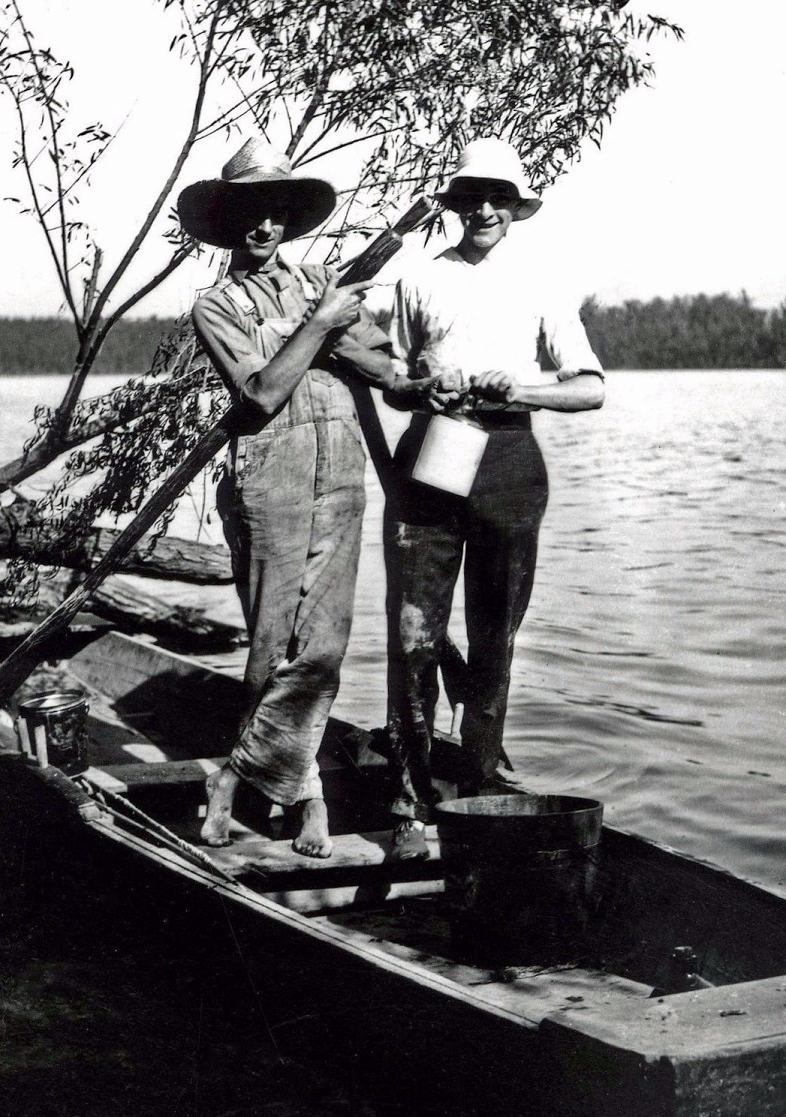
Twins fishing from a skiff on a River
From vintagetreasureshq on eBay came this 5 x 7 photo copy of a snap shot listed as: Vintage Photo Country Boys Fish Mississippi River Boat Probably taken at high noon with dark shadows and overhead light source. An eclectic assortment of historical imagery is available from vintage treasures including Hippolyte Sebron's 1850 painting of giant steamboats at New Orleans: Unique Photo Old Riverboat Pictures Vintage Steam Boat Photos 5x7 Print X335
The height & build, plus the noses, mouths and chins of both of these young men's faces suggests that they were brothers, perhaps twins. There are bamboo fishing poles in the skiff they're standing in, the jug may still contain corn liquor or could have been employed for the "jugging" technique of fishing. Young feller on the left's fashion statement of wide straw hat, bib overalls and bare feet is a classic riverboy/riverman's wardrobe. This image will be right at home on the Huck and Tom pages.
Jim Waddell who portrays Sam Clemens in Hannibal at the Mark Twain Museum and the Cave weighed in on fishing in a candid and amusing way:
"In my experience, this type of fishing has always been called "running a trotline" and the advent of plastic one-gallon milk jugs has greatly facilitated it. It's a good way to catch a hundred pounds of fish in a short period of time with very little effort. Angling has never appealed to me though I did participate frequently as a boy. Generally, I recall the experiences as being too hot, too cold, too muddy, too little response from the intended prey, too many knots in the line, too many mosquitoes, and, once returned from the foray, you had to clean the darned things. The thrill of the catch is a strong recommendation but I grew up in a generation of grocery store convenience where the obtaining of bounty was no longer celebratory."
Jim Hale, my steamboat model builder friend in Alabama also weighed in on fishing Down South:
"THANKS FOR THE PHOTO OF THE TWO BOYS IN THEIR FISHING BOAT. ALL THE FISHING CAMPS ON THE WARRIOR RIVER HAD HOMEMADE JOHN BOATS LIKE THIS ONE WHEN I WAS A KID AND MY FATHER AND I WOULD GO TO ONE OF THE CAMPS AND RENT ONE FOR $2.00 A DAY AND SET OUT A TROT LINE AND LEAVE IT TILL NEXT DAY WHEN WE WOULD GO BACK AND RUN IT. SOMETIMES WE WOULD GET LUCKY AND CATCH A GOOD SIZE CATFISH.
I DON'T THINK THE JUG IN THIS PICTURE IS FOR JUG FISHING. DRINKING WATER MOST LIKELY THOUGH IT COULD BE WHITE LIGHTNING. THIS PICTURE LOOKS POSED SO I DON'T KNOW IF THEY ARE TRULY GOING FISHING OR NOT. IF THEY ARE NOT TWINS THEY SURELY ARE BROTHERS. MY DAD HAD A SMALL 5 HORSE OUTBOARD MOTOR WE WOULD TAKE TO THE RIVER WITH US AND PUT IT ON THE BACK OF THE BOAT WE RENTED. THOSE WERE THE GOOD OLD DAYS AND I LOVED IT."
An 8 paragraph fishing guide by Dan Eggersten describes the technique of "jugging" for catfish at this link:
streetdirectory.com
The Basics of Jugging For Catfish - Techniques and Tips By: Daniel Eggertsen Jugging for catfish is a great way to catch tons of fish, with a minimum of cost or effort. You'll see it sometimes called 'juglining,' but it's the same thing. It basically involves putting a bunch of jugs out there in the water that have a line running in between them, and on that line are your hooks.
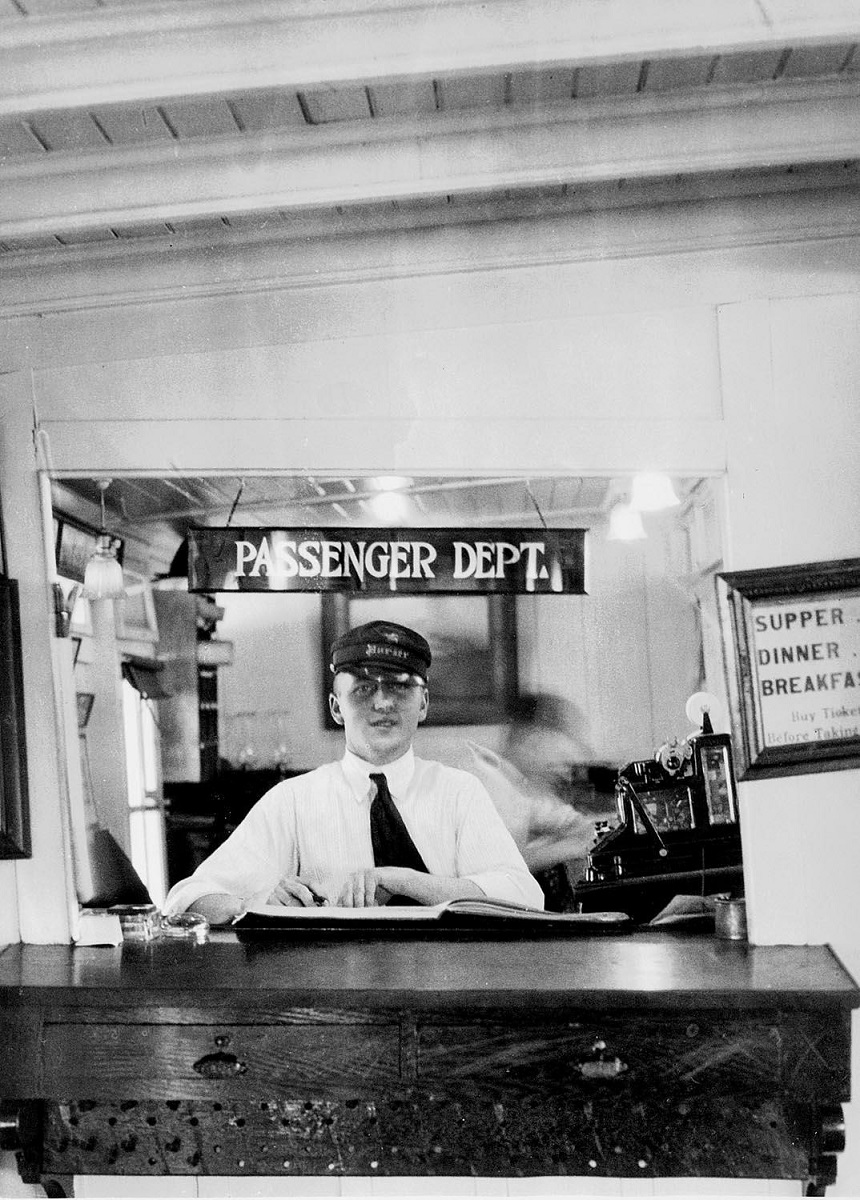
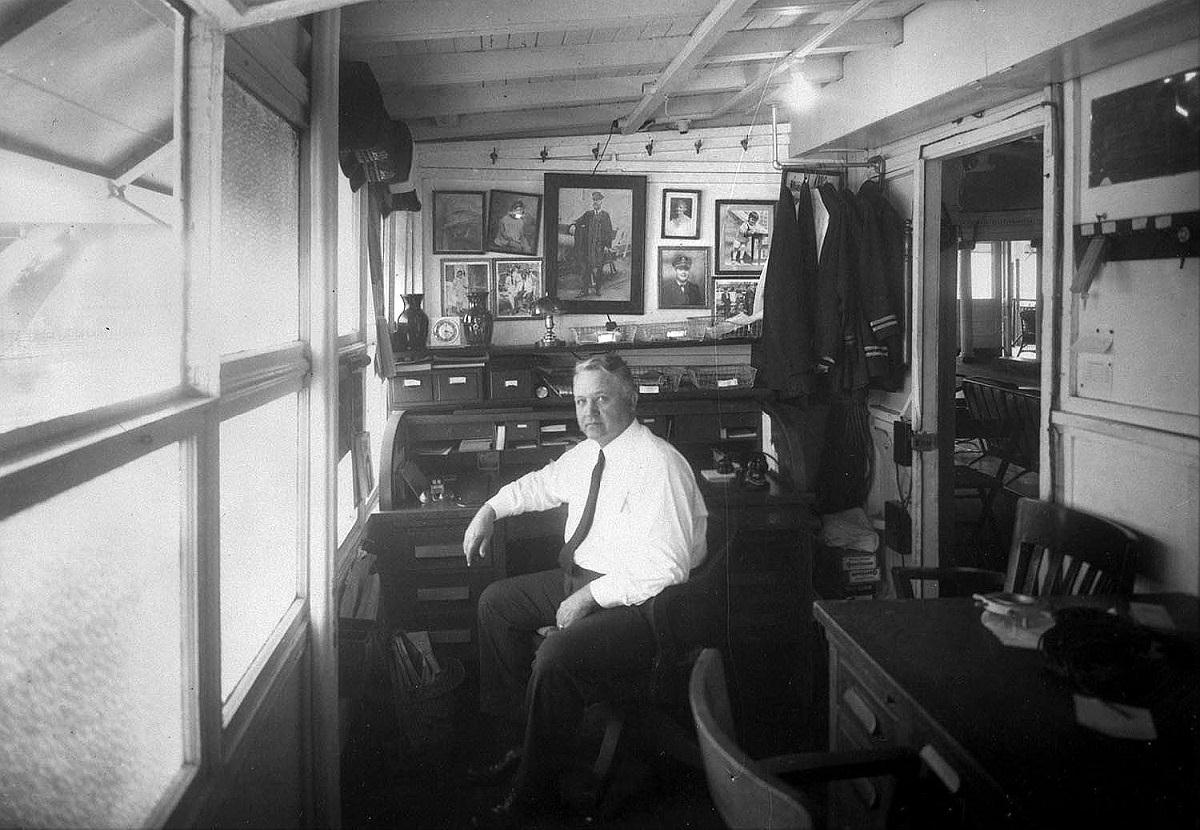
Purser's office QUEEN CITY and Cap'n Roy Streckfus in his office on the CAPITOL
Excellent photo of Purser Ray McKay in his office with a blurry "ghost" of a clerk who moved during the time exposure was seated behind him. Sign "PASSENGER DEPT" overhead and framed list of tickets available there for "supper, dinner & breakfast" but prices are cropped out on the right. A distinctive "Dutch angle" tilt to the frame of the window opening is typical of steamboat architecture inside and out.
Captain Roy Streckfus sits at his roll top desk in the more plumbed up office of the CAPITOL in the second photo. Uniform coats hang next to the door, uniform caps above the window and family photos as civilians and steamboat officers are displayed above the desk. The slant to the beams in the ceiling overhead are typical steamboat in style. Main cabin glimpsed through doorway and a bridge through the window.
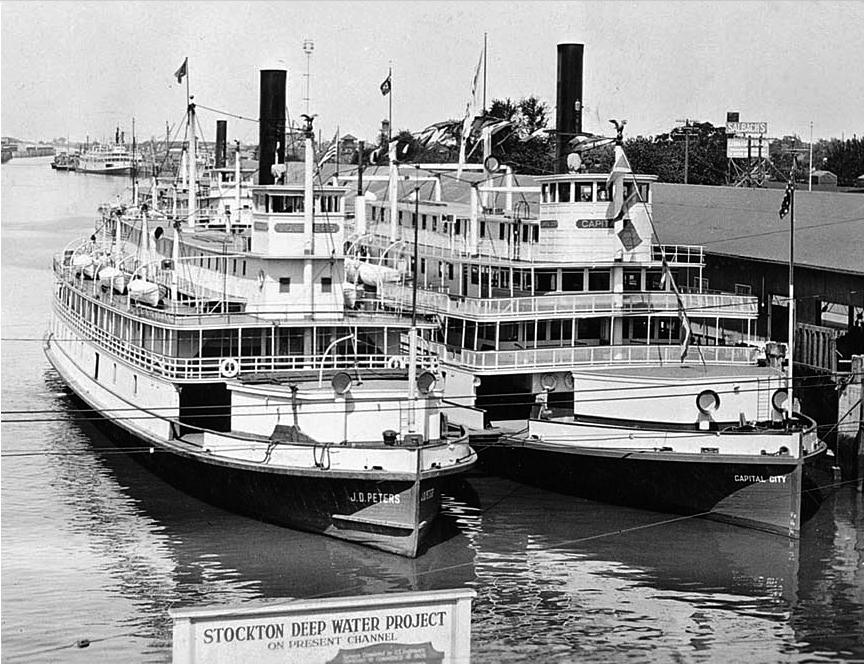
Sternwheeler helped drain flooded island in 1938
Novelty photo of Sacramento River steamer J.D. PETERS helping to reclaim flooded Mandeville Island in the San Joaquin River in 1938. Included is a detail from a La Crosse photo of the J.D. PETERS alongside the CAPITAL CITY at Stockton, CA.
Old steamboats dry out inundated islands in California
STOCKTON, CALIFORNIA: JUNE 10, 1938 Photo by Acme News Service
A new use has been found for old steamboats - - - that of drying out inundated islands. High flood waters in the Delta of the San Joaquin River broke through a levee to flood Mandeville Island, which is now below river level.
To dry off the land, a fleet of 4 river steamboats including the J.D. PETERS (built in 1889) in this photograph, were taken inside the island area through the levee break. The levee was sealed and the old old steamers backed up so their stern paddlewheels were positioned in front of trough-like flumes over the levee. With their boilers going and paddlewheels churning and the boats secured so they can't move, they are raising the water into the flumes which flows back into the river. Meanwhile the island area, which is 1600 flooded acres in extent with water 10 feet deep, is expected to be reclaimed in time for fall planting. When the island is dried out the once proud river steamers will be used as bunkhouses for ranch hands.

With the exception of images credited to public institutions,
everything on this page is from a private collection.
Please contact Steamboats.com for permission for commercial use.*
All captions provided by Dave Thomson, Steamboats.com primary contributor and historian.
